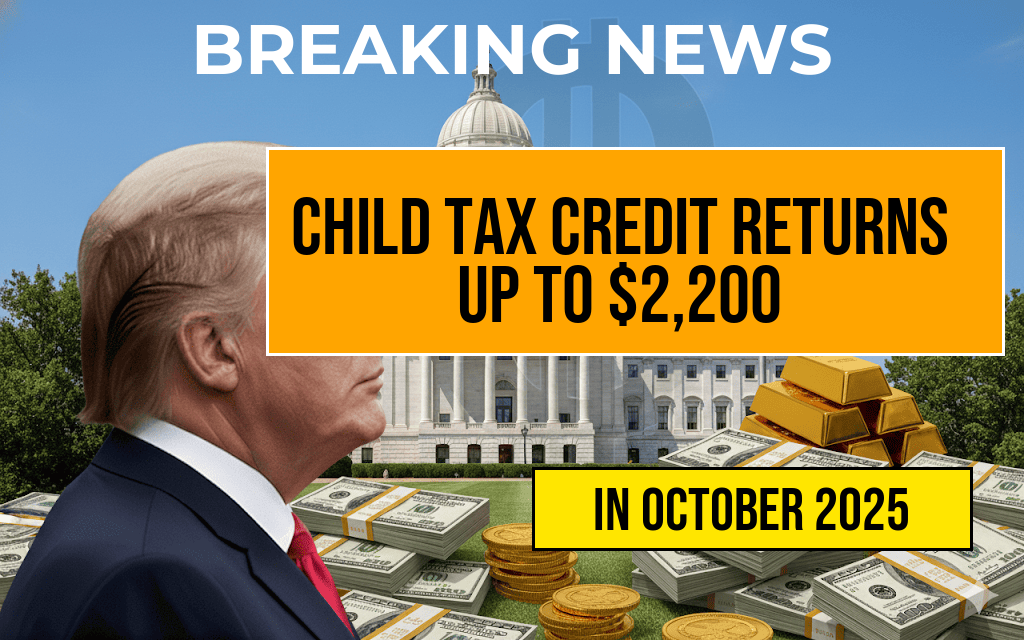The upcoming tax year will see a significant boost in the Child Tax Credit (CTC), offering qualifying families up to $2,200 per child. This increase aims to support millions of households facing ongoing economic challenges, especially those with lower to middle incomes. The expanded credit is part of recent legislative changes designed to make child-related expenses more manageable and reduce child poverty rates. Families can begin claiming the enhanced benefits when they file their 2023 taxes in early 2024, with the IRS implementing streamlined procedures to ensure quick and efficient disbursement. The revamped Child Tax Credit not only raises the maximum amount families can receive but also broadens eligibility criteria, allowing more children and families to benefit from this federal support. As discussions around economic relief persist, experts emphasize the importance of understanding eligibility requirements and the potential impact on household budgets.
Understanding the New Child Tax Credit Framework
Key Changes for the 2023 Tax Year
- Maximum benefit per child: Increased to $2,200 from previous levels, with a portion potentially refundable.
- Expanded eligibility: More families qualify due to adjusted income thresholds and simplified criteria.
- Age range extension: Children up to age 17 can now be claimed, broadening the scope beyond previous limits.
How the Credit Is Calculated
The credit amount for each qualifying child is based on a combination of factors, including household income and number of children. For families with incomes below certain thresholds, the entire amount may be refundable, meaning they can receive the full credit even if they owe no tax. The IRS has provided detailed guidelines to help taxpayers determine their eligibility and the exact amount they can expect to receive, which can be accessed through their official website.
Eligibility Criteria and Income Thresholds
| Filing Status | Maximum Income for Full Credit | Partial Credit Phase-Out Begins At |
|---|---|---|
| Single / Head of Household | $75,000 | $200,000 |
| Married Filing Jointly | $110,000 | $400,000 |
| Married Filing Separately | Not specified | Lower thresholds apply |
Income thresholds determine the phase-out of the credit, gradually reducing the amount received as income rises. Notably, the IRS has increased the income limits to accommodate middle-income families, making the credit accessible to a broader demographic. Families with incomes just above these thresholds may still qualify for partial benefits.
Implications for Families and Economic Support
Impact on Household Budgets
Financial experts suggest that the boost in the Child Tax Credit could provide substantial relief for families managing childcare costs, education expenses, and other child-related needs. For many, the additional $2,200 per child can be a lifeline, helping to alleviate the burden of rising inflation and economic uncertainty. This expanded credit aligns with broader efforts to reduce child poverty and foster economic stability among vulnerable populations.
Distribution and Claiming Process
Taxpayers can claim the enhanced Child Tax Credit when filing their 2023 federal returns, with some families potentially receiving advance payments during the year through periodic payments from the IRS. The agency encourages eligible families to use the Child Tax Credit portal on their website to verify their eligibility and update relevant information. The IRS has also increased outreach efforts to ensure families are aware of these changes and understand how to maximize their benefits.
Expert Perspectives and Policy Context
Advocates’ Viewpoints
Child welfare organizations and economic policy analysts praise the increase, highlighting its potential to significantly reduce child poverty rates. According to the Wikipedia entry on child poverty in the U.S., federal safety net programs like the Child Tax Credit have historically played a crucial role in supporting vulnerable families. Advocates argue that sustained investment in such programs is vital for long-term economic growth and social equity.
Critics and Challenges
Some critics express concern over the cost implications of expanding the credit, emphasizing the importance of ensuring the program’s sustainability. Others note that bureaucratic hurdles and lack of awareness may limit the program’s reach, urging policymakers to improve outreach and simplify claiming procedures to ensure maximum participation.
Looking Ahead
As the 2023 tax season approaches, families are encouraged to review eligibility criteria and prepare documentation to claim the full benefits of the Child Tax Credit. The federal government’s renewed focus on child welfare through financial support reflects broader policy efforts to create a more equitable economic landscape. Staying informed about updates from the IRS and consulting tax professionals can help families optimize their claims and leverage the full scope of available assistance.
Frequently Asked Questions
What is the Child Tax Credit for next year?
The Child Tax Credit for next year offers families up to $2,200 per qualifying child, providing significant financial support to help with childcare and related expenses.
Who qualifies for the Child Tax Credit?
Families with children under age 17 who meet income requirements and are U.S. citizens or residents typically qualify for the Child Tax Credit.
How will families receive the Child Tax Credit next year?
Eligible families will receive the Child Tax Credit either as part of their monthly payments or through a lump sum when they file their tax returns.
Are there any changes to the eligibility criteria for the Child Tax Credit?
Yes, the upcoming changes include adjusted income limits and expanded eligibility for certain families, making more families eligible for the up to $2,200 per child.
How can families claim the Child Tax Credit?
Families can claim the Child Tax Credit by filing their federal tax returns and completing the relevant IRS forms. It is recommended to keep records of qualifying children handy for accurate claims.








